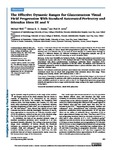The Effective Dynamic Ranges for Glaucomatous Visual Field Progression With Standard Automated Perimetry and Stimulus Sizes III and V
| dc.contributor.author | Wall, M | |
| dc.contributor.author | Zamba, GKD | |
| dc.contributor.author | Artes, Paul | |
| dc.date.accessioned | 2018-02-16T17:45:45Z | |
| dc.date.available | 2018-02-16T17:45:45Z | |
| dc.date.issued | 2018-01-22 | |
| dc.identifier.issn | 1552-5783 | |
| dc.identifier.issn | 1552-5783 | |
| dc.identifier.uri | http://hdl.handle.net/10026.1/10808 | |
| dc.description.abstract |
PURPOSE: It has been shown that threshold estimates below approximately 20 dB have little effect on the ability to detect visual field progression in glaucoma. We aimed to compare stimulus size V to stimulus size III, in areas of visual damage, to confirm these findings by using (1) a different dataset, (2) different techniques of progression analysis, and (3) an analysis to evaluate the effect of censoring on mean deviation (MD). METHODS: In the Iowa Variability in Perimetry Study, 120 glaucoma subjects were tested every 6 months for 4 years with size III SITA Standard and size V Full Threshold. Progression was determined with three complementary techniques: pointwise linear regression (PLR), permutation of PLR, and linear regression of the MD index. All analyses were repeated on "censored'' datasets in which threshold estimates below a given criterion value were set to equal the criterion value. RESULTS: Our analyses confirmed previous observations that threshold estimates below 20 dB contribute much less to visual field progression than estimates above this range. These findings were broadly similar with stimulus sizes III and V. CONCLUSIONS: Censoring of threshold values < 20 dB has relatively little impact on the rates of visual field progression in patients with mild to moderate glaucoma. Size V, which has lower retest variability, performs at least as well as size III for longitudinal glaucoma progression analysis and appears to have a larger useful dynamic range owing to the upper sensitivity limit being higher. | |
| dc.format.extent | 439-439 | |
| dc.format.medium | ||
| dc.language | en | |
| dc.language.iso | eng | |
| dc.publisher | Association for Research in Vision and Ophthalmology (ARVO) | |
| dc.subject | automated perimetry | |
| dc.subject | visual field | |
| dc.subject | glaucoma | |
| dc.title | The Effective Dynamic Ranges for Glaucomatous Visual Field Progression With Standard Automated Perimetry and Stimulus Sizes III and V | |
| dc.type | journal-article | |
| dc.type | Journal Article | |
| dc.type | Research Support, Non-U.S. Gov't | |
| dc.type | Research Support, U.S. Gov't, Non-P.H.S. | |
| plymouth.author-url | https://www.webofscience.com/api/gateway?GWVersion=2&SrcApp=PARTNER_APP&SrcAuth=LinksAMR&KeyUT=WOS:000425855900054&DestLinkType=FullRecord&DestApp=ALL_WOS&UsrCustomerID=11bb513d99f797142bcfeffcc58ea008 | |
| plymouth.issue | 1 | |
| plymouth.volume | 59 | |
| plymouth.publication-status | Published | |
| plymouth.journal | Investigative Opthalmology & Visual Science | |
| dc.identifier.doi | 10.1167/iovs.17-22390 | |
| plymouth.organisational-group | /Plymouth | |
| plymouth.organisational-group | /Plymouth/Faculty of Health | |
| plymouth.organisational-group | /Plymouth/Faculty of Health/School of Health Professions | |
| plymouth.organisational-group | /Plymouth/REF 2021 Researchers by UoA | |
| plymouth.organisational-group | /Plymouth/REF 2021 Researchers by UoA/UoA03 Allied Health Professions, Dentistry, Nursing and Pharmacy | |
| plymouth.organisational-group | /Plymouth/Research Groups | |
| plymouth.organisational-group | /Plymouth/Research Groups/Institute of Health and Community | |
| plymouth.organisational-group | /Plymouth/Users by role | |
| plymouth.organisational-group | /Plymouth/Users by role/Academics | |
| dc.publisher.place | United States | |
| dc.identifier.eissn | 1552-5783 | |
| dc.rights.embargoperiod | Not known | |
| rioxxterms.versionofrecord | 10.1167/iovs.17-22390 | |
| rioxxterms.licenseref.uri | http://www.rioxx.net/licenses/all-rights-reserved | |
| rioxxterms.type | Journal Article/Review |


